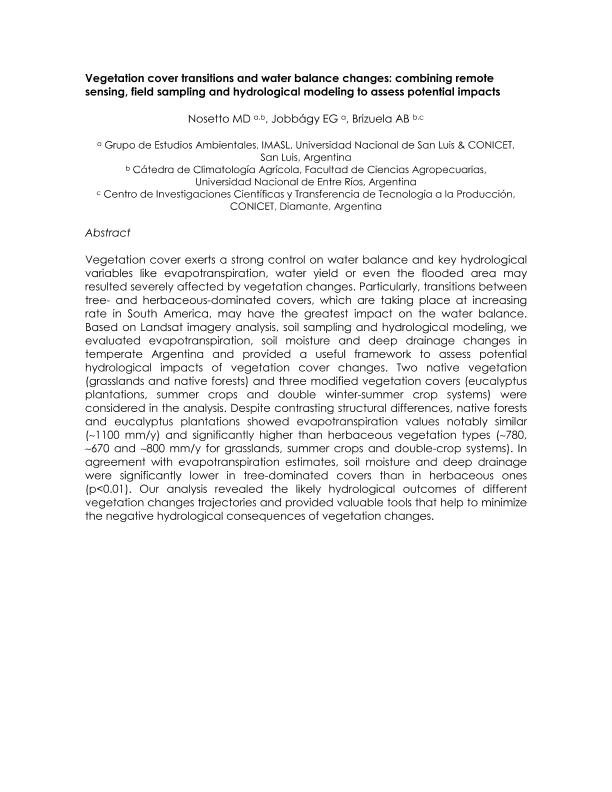Artículo
The hydrologic consequences of land cover change in central Argentina
Nosetto, Marcelo Daniel ; Jobbagy Gampel, Esteban Gabriel
; Jobbagy Gampel, Esteban Gabriel ; Brizuela, Armando Benito
; Brizuela, Armando Benito ; Jackson, R. B.
; Jackson, R. B.
 ; Jobbagy Gampel, Esteban Gabriel
; Jobbagy Gampel, Esteban Gabriel ; Brizuela, Armando Benito
; Brizuela, Armando Benito ; Jackson, R. B.
; Jackson, R. B.
Fecha de publicación:
04/2012
Editorial:
Elsevier
Revista:
Agriculture, Ecosystems And Environment
ISSN:
0167-8809
Idioma:
Inglés
Tipo de recurso:
Artículo publicado
Clasificación temática:
Resumen
Vegetation exerts a strong control on water balance and key hydrological variables like evapotranspiration,water yield or even the flooded area may result severely affected by vegetation changes. Particularly,transitions between tree- and herbaceous-dominated covers, which are taking place at increasing rates in South America,may have the greatest impact on the water balance. Based on Landsat imagery analysis,soil sampling and hydrological modeling, we evaluated vapor and liquid ecosystem water fluxes and soil moisture changes in temperate Argentina and provided a useful framework to assess potential hydrological impacts of vegetation cover changes. Two types of native vegetation (grasslands and forests) and three modified covers (eucalyptus plantations, single soybean crop and wheat/soybean rotation) were considered in the analysis. Despite contrasting structural differences, native forests and eucalyptus plantations displayed evapotranspiration values remarkably similar (∼1100 mmy−1) and significantly higher than herbaceous vegetation covers (∼780,∼670 and∼800 mmy−1 for grasslands, soybean andwheat/soybean (Triticum aestivum L., Glycine max L.) system, respectively. In agreement with evapotranspiration estimates, soil profiles to a depth of 3m were significantly drier in woody covers (0.31 m3 m−3) compared to native grasslands (0.39 m3 m−3), soybean (0.38 m3 m−3) and wheat/soybean rotation (0.35 m3 m−3). Liquid water fluxes (deep drainage + surface runoff) were at least doubled in herbaceous covers, as suggested by modeling (∼170 mmy−1 and ∼357 mmy−1, for woody and herbaceous covers, respectively). Our analysis revealed the hydrological outcomes of different vegetation changes trajectories and provided valuable tools that will help to anticipate likely impacts, minimize uncertainties and provide a solid base for sustainable land use planning.
Palabras clave:
Vegetation Cover
,
Water Balance
,
Hydrological Modeling
Archivos asociados
Licencia
Identificadores
Colecciones
Articulos(IMASL)
Articulos de INST. DE MATEMATICA APLICADA DE SAN LUIS
Articulos de INST. DE MATEMATICA APLICADA DE SAN LUIS
Articulos(SEDE CENTRAL)
Articulos de SEDE CENTRAL
Articulos de SEDE CENTRAL
Citación
Nosetto, Marcelo Daniel; Jobbagy Gampel, Esteban Gabriel; Brizuela, Armando Benito; Jackson, R. B.; The hydrologic consequences of land cover change in central Argentina; Elsevier; Agriculture, Ecosystems And Environment; 154; 4-2012; 2-11
Compartir
Altmétricas



